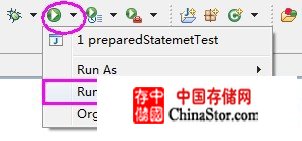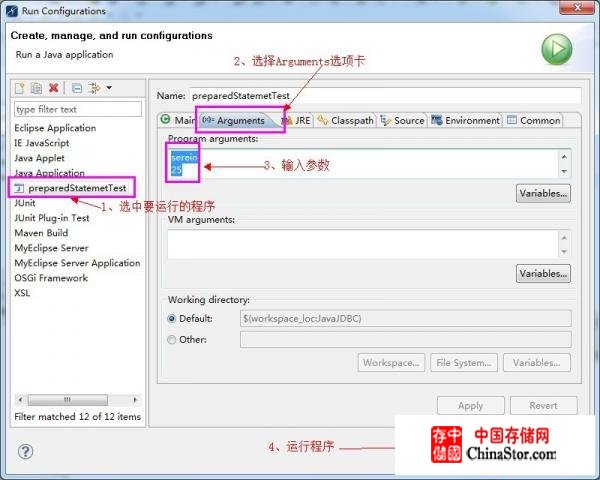从上一篇文章《JDBC连接MySQL数据库及示例》(前往该文章)的示例中,我们提到,使用Statement来执行SQL语句,例如:Connection connection;Statement statement ;... ...statement = con
Connection connection;
Statement statement ;
... ...
statement = connction.creatStatement();
String sql = "INSERT INTO staff(name, age, sex,address, depart, worklen,wage)" + " VALUES ('Serein', 25, 'M', 'Guangzhou','Engine','1','5000')";
st.executeUpdate(sql);
上述代码中,需要构造的SQL语句很长很麻烦,尤其是对参数,很容易出错。所以Sun提供了更高级的Statement,即PreparedStatement。本文就来学习PreparedStatement。
一、什么是PreparedStatement
参阅Java API文档,我们可以知道,PreparedStatement是Statement的子接口(如图所示),表示预编译的 SQL 语句的对象,SQL 语句被预编译并存储在PreparedStatement 对象中。然后可以使用此对象多次高效地执行该语句。

二、通过PreparedStatement获取在运行命令行中执行的参数,将参数插入到某张数据表中
相关的实验过程,包括在预先创建程序所需数据库、创建所需数据表格、在开发环境中加载驱动程序包等,可参考前一篇文章《JDBC连接MySQL数据库及示例》(前往该文章)具体
package com.serein.jdbc;import java.sql.*;
public class preparedStatemetTest {
public static void main(String[] args) {
//检查命令行中是否够7个参数
if(args.length != 7) {
System.out.println("Parameter Error! Please Input Again!");
System.exit(-1);
}
//程序获取运行栈里的7个参数值
String name = args[0];
int age = 0;
try {
age = Integer.parseInt(args[1]);
} catch (NumberFormatException e) {
System.out.println("Parameter Error! Age should be Number Format!");
System.exit(-1);
}
String sex = args[2];
String address = args[3];
String depart = args[4];
int worklen = 0;
try {
worklen = Integer.parseInt(args[5]);
} catch (NumberFormatException e) {
System.out.println("Parameter Error! Worklen should be Number Format!");
System.exit(-1);
}
int wage = 0;
try {
wage = Integer.parseInt(args[6]);
} catch (NumberFormatException e) {
System.out.println("Parameter Error! Wage should be Number Format!");
System.exit(-1);
}
//创建PreparedStatement对象
PreparedStatement pstmt = null;
//创建连接对象
Connection conn = null;
//连接数据库,并插入数据
try {
//加载MySQL驱动实例,提供了两种方法,是等价的
Class.forName("com.mysql.jdbc.Driver");
//new oracle.jdbc.driver.OracleDriver();
//建立连接
conn = DriverManager.getConnection("jdbc:mysql://localhost:3306/myuser", "root", "root");
//使用PreparedStatement对象里来构建并执行SQL语句,7个问号代表7个字段预先要保留的值
pstmt = conn.prepareStatement("INSERT INTO staff(name, age, sex,address, depart, worklen,wage) VALUES (?, ?, ?, ?, ?, ?, ?)");
//通过PreparedStatement对象里的set方法去设置插入的具体数值
pstmt.setString(1, name);
pstmt.setInt(2, age);
pstmt.setString(3, sex);
pstmt.setString(4,address );
pstmt.setString(5, depart);
pstmt.setInt(6, worklen);
pstmt.setInt(7, wage);
pstmt.executeUpdate();
//插入成功提示
System.out.print("成功插入一条数据记录!");
//捕获驱动加载失败异常
} catch (ClassNotFoundException e) {
e.printStackTrace();
//捕获SQL语句执行失败异常
} catch (SQLException e) {
e.printStackTrace();
//恢复变量初始值
} finally {
try {
if(pstmt != null) {
pstmt.close();
pstmt = null;
}
if(conn != null) {
conn.close();
conn = null;
}
//捕获SQL异常
} catch (SQLException e) {
e.printStackTrace();
}
}
}
}
编写好代码之后,要进行带参数运行程序,方法如下:


其中输入的参数为(可参考进行修改):
SereinChan
25
M
Guangzhou
Engine
3
5000
查看Console控制台,"成功插入一条数据记录!":

查看MySQL数据库,进行确认:

成功完成!
声明: 此文观点不代表本站立场;转载须要保留原文链接;版权疑问请联系我们。









